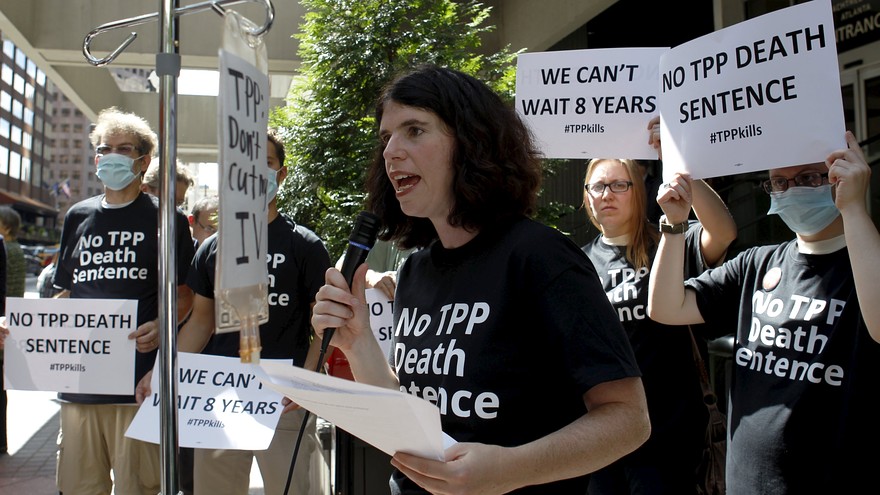TPP’s impact on global trade still far from assured

Opponents of the Trans-Pacific Partnership protest outside the trade ministers’ meeting held in Atlanta, which lasted from Sept. 30 to Oct. 5.
Trade ministers from 12 countries recently announced the conclusion of negotiations on the Trans-Pacific Partnership (TPP) led by the US, which has become a controversial issue among the public. As a fledgling agreement fraught with uncertainty, its characteristics, benefits and possible impact on China’s foreign investments as well as the current pattern of international trade need to be further analyzed.
Zhang Zhenjiang, dean of the School of International Studies at Jinan University in Guangdong Province, said that the legislatures of all member nations still need to ratify the agreement. In the US, since the presidential election is approaching, ratification in the Congress will not be an easy task, and similar problems also loom ahead for other member countries of the TPP.
For more than five years, negotiators have haggled over the agreement through dozens of rounds and finally cobbled together an agreement, the difficulty of which indicates that the TPP’s implementation is still far from assured. “Some key provisions of the TPP could take years to be implemented, even as long as three decades,” said Shi Yinhong, a professor from the School of International Studies at Renmin University of China.
Lei Da, a professor from the School of Economics at Renmin University of China, also said that due to huge differences between the economic structures of the 12 member countries, it is implausible that the US will be able to foster a high-standard, high-level feasible world trade system under the framework of the TPP.
The fact that China, the world’s second largest economy and one of the most important Asia-Pacific countries, is not included within the TPP has prompted attention from the international community. Some say that China’s absence in the TPP makes it an “orphan of the Pacific Rim,” a statement which is considered overblown by the many scholars interviewed.
“It is no doubt radically wrong to claim that countries excluded from the TPP face a dead end,” said Lei Da. “Currently, the international economic order is undergoing profound and complex changes, in the context of which, many countries are seeking new development paths apart from the former international economic mechanisms like the WTO and IMF. The TPP is one of the new paths, but absolutely not the only one. There are diverse ways towards economic integration.”
In fact, without China’s participation, any international organization or economic arrangement in the Asia-Pacific region would be incomplete. This has become the consensus of more and more scholars from both home and abroad. Peter Pater, a professor from the International School at Brandeis University, said, if China, South Korea, the Philippines, Thailand, Indonesia join the TPP, the revenue of the US would dramatically increase by 2025 possibly to about $ 333 billion.
“I’m afraid that for any regional economic and trade pact to be upheld as the global rule, the China-US consensus is indispensable,” said Shen Minghui, associate research fellow from the National Institute of International Strategy at the Chinese Academy of Social Sciences (CASS).
Joshua Meltzer, a research fellow from the Brookings Institution, also wrote that the first and foremost task is concluding the China-US Bilateral Investment Treaty (BIT) covering intellectual property protection, which is also a component of the TPP. In addition, he suggests the two countries should also consider reinvigorating multilateral negotiations under the framework of the WTO.
Being either over-anxious or turning a deaf ear to the TPP is not advisable, as Zhang said: “Negotiations over the TPP have come to an end, and what China should do concerning this is an urgent issue.”
China has always harbored an open attitude toward the TPP. Decisions on whether to join and when to join need to be based on an objective cost-benefit analysis, Shen said. “Steady decision making is particularly important to China, a developing country with complete functional departments and huge economic volume.”
Dong Yuping, director assistant of the Institute of Finance and Banking at CASS, said that in order to respond to the impacts of the TPP in a rational way, China needs to conduct a complete and systematic assessment of TPP provisions. He then further put forward three ideas to address the challenges brought by the TPP: first, stick to the policy of opening up to the world; second, technically speaking, reach the Free Trade Agreements (FTA) with countries concerned and advance the negotiations to upgrade the Regional Comprehensive Economic Partnership (RCEP), China-Japan-South Korea Free Trade Zone and China-ASEAN Free Trade Zone; third, accelerate the economic restructuring and strengthen China’s competitiveness in the international stage because the evolution of the international trade pattern, fundamentally speaking, is decided by the world industrial structure and the competitiveness of each country’s products in international markets.
No longer a country reliant on the advantages brought by cheap labor costs, today’s China is transforming its economy into an ultra-large market that mainly relies on domestic demand, the huge appeal of which, is something that TPP could not stop.
“As it remains stable and open with a growing economy, China will face more opportunities than challenges,” Zhang Zhenjiang concluded.
